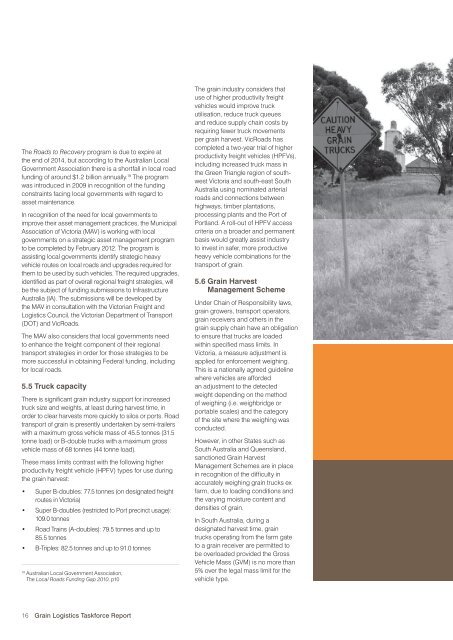Grain Logistics Taskforce Report - Department of Transport
Grain Logistics Taskforce Report - Department of Transport
Grain Logistics Taskforce Report - Department of Transport
Create successful ePaper yourself
Turn your PDF publications into a flip-book with our unique Google optimized e-Paper software.
The Roads to Recovery program is due to expire atthe end <strong>of</strong> 2014, but according to the Australian LocalGovernment Association there is a shortfall in local roadfunding <strong>of</strong> around $1.2 billion annually. 19 The programwas introduced in 2009 in recognition <strong>of</strong> the fundingconstraints facing local governments with regard toasset maintenance.In recognition <strong>of</strong> the need for local governments toimprove their asset management practices, the MunicipalAssociation <strong>of</strong> Victoria (MAV) is working with localgovernments on a strategic asset management programto be completed by February 2012. The program isassisting local governments identify strategic heavyvehicle routes on local roads and upgrades required forthem to be used by such vehicles. The required upgrades,identifi ed as part <strong>of</strong> overall regional freight strategies, willbe the subject <strong>of</strong> funding submissions to InfrastructureAustralia (IA). The submissions will be developed bythe MAV in consultation with the Victorian Freight and<strong>Logistics</strong> Council, the Victorian <strong>Department</strong> <strong>of</strong> <strong>Transport</strong>(DOT) and VicRoads.The MAV also considers that local governments needto enhance the freight component <strong>of</strong> their regionaltransport strategies in order for those strategies to bemore successful in obtaining Federal funding, includingfor local roads.5.5 Truck capacityThere is signifi cant grain industry support for increasedtruck size and weights, at least during harvest time, inorder to clear harvests more quickly to silos or ports. Roadtransport <strong>of</strong> grain is presently undertaken by semi-trailerswith a maximum gross vehicle mass <strong>of</strong> 45.5 tonnes (31.5tonne load) or B-double trucks with a maximum grossvehicle mass <strong>of</strong> 68 tonnes (44 tonne load).These mass limits contrast with the following higherproductivity freight vehicle (HPFV) types for use duringthe grain harvest:• Super B-doubles: 77.5 tonnes (on designated freightroutes in Victoria)• Super B-doubles (restricted to Port precinct usage):109.0 tonnes• Road Trains (A-doubles): 79.5 tonnes and up to85.5 tonnes• B-Triples: 82.5 tonnes and up to 91.0 tonnes19Australian Local Government Association,The Local Roads Funding Gap 2010, p10The grain industry considers thatuse <strong>of</strong> higher productivity freightvehicles would improve truckutilisation, reduce truck queuesand reduce supply chain costs byrequiring fewer truck movementsper grain harvest. VicRoads hascompleted a two-year trial <strong>of</strong> higherproductivity freight vehicles (HPFVs),including increased truck mass inthe Green Triangle region <strong>of</strong> southwestVictoria and south-east SouthAustralia using nominated arterialroads and connections betweenhighways, timber plantations,processing plants and the Port <strong>of</strong>Portland. A roll-out <strong>of</strong> HPFV accesscriteria on a broader and permanentbasis would greatly assist industryto invest in safer, more productiveheavy vehicle combinations for thetransport <strong>of</strong> grain.5.6 <strong>Grain</strong> HarvestManagement SchemeUnder Chain <strong>of</strong> Responsibility laws,grain growers, transport operators,grain receivers and others in thegrain supply chain have an obligationto ensure that trucks are loadedwithin specifi ed mass limits. InVictoria, a measure adjustment isapplied for enforcement weighing.This is a nationally agreed guidelinewhere vehicles are affordedan adjustment to the detectedweight depending on the method<strong>of</strong> weighing (i.e. weighbridge orportable scales) and the category<strong>of</strong> the site where the weighing wasconducted.However, in other States such asSouth Australia and Queensland,sanctioned <strong>Grain</strong> HarvestManagement Schemes are in placein recognition <strong>of</strong> the diffi culty inaccurately weighing grain trucks exfarm, due to loading conditions andthe varying moisture content anddensities <strong>of</strong> grain.In South Australia, during adesignated harvest time, graintrucks operating from the farm gateto a grain receiver are permitted tobe overloaded provided the GrossVehicle Mass (GVM) is no more than5% over the legal mass limit for thevehicle type.16 <strong>Grain</strong> <strong>Logistics</strong> <strong>Taskforce</strong> <strong>Report</strong>
















